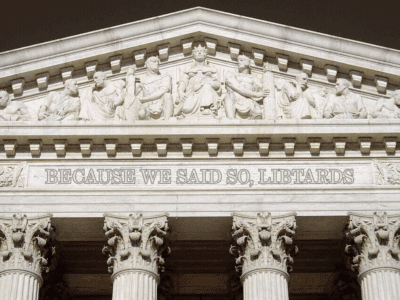Legal “Scholarship” and the Overproduction of Elites
What's the point of writing about the Supreme Court when its only ideology is intellectual dishonesty?
Why do we even bother with this anymore? The New York Times breathlessly reports that the University of Virginia’s Caleb Nelson, a well-respected originalist scholar, has concluded that the “unitary executive theory,” long promoted by conservatives, is, well, bunk. “A bombshell!,” enthuses Will Baude of the University of Chicago, himself a well-respected originalist scholar – a description that the Times puts in its headline. That would be – no. ...
CONTINUE READINGLighting Candles in Dark Times: Environmental Law Centers in the Trump Era
These law school centers show it’s possible find ways to make a difference.
Environmental laws have become vibrant parts of the law and policy ecosystem. At a time when despondency seems all too common, the work of these law school centers offers beacons of hope for the future of environmental protection. Some of that work is playing defense — pushing back against deregulatory efforts — while other work plays offense by identifying innovative directions for environmental policy. A comprehensive survey isn’t practical, but I’ll pro...
CONTINUE READINGBackfilling the federal ESA
AB 1319 is a good first step to responding to efforts to weaken the federal ESA
I wrote this past spring about a proposal by the Trump Administration to eliminate the definition of harm in the regulations implementing the federal Endangered Species Act (ESA), which might eliminate protections from habitat modification for federally listed species. I also noted three different steps California could do to backfill the federal ESA if such a regulatory change occurred to ensure that at least California species remained protected. The legislature h...
CONTINUE READINGWhich is Better: LADWP or SCE?
New UCLA Law report, "The Cost & Carbon of Competing Utility Models," contrasts municipally owned electric utilities and investor-owned utilities.
One of our three main areas of focus at the Emmett Clean Energy Law & Leadership (E-CELL) initiative is Ownership of Energy Resources: exploring how utility ownership structures affect cost, climate, and other outcomes. In June, we released a Pritzker Brief on this topic co-authored by our recent legal fellow, Ruthie Lazenby, as well as Mohit Chhabra of NRDC and Sylvie Ashford of TURN. That paper explored the theoretical underpinnings differentiating between publ...
CONTINUE READINGRevoking Monuments?
Recent Justice Department memo on National Monuments argues for Presidential power to eliminate them entirely
National monuments were a major flashpoint for public lands management under the first Trump Administration, which dramatically shrank two national monuments in Utah. I think there was a broad expectation that the second Trump Administration would do the same, but for more monuments (including those designated under the Biden Administration), but so far not much has happened. One possibility is that the Trump Administration is hoping that litigation challenging the A...
CONTINUE READINGArson Alone Does Not Explain the Palisades Fire
The Drain is a weekly roundup of environmental and climate news from Legal Planet.
When federal prosecutors charged a man last week with intentionally starting a brushfire that was suppressed but smoldered and ultimately became the Palisades fire, arson became the focus of attention all week. The city’s after-action report about the fire was totally overshadowed by questions around the suspect. What was his motive? Is there strong evidence? It’s almost as if arson became the sole explanation for one of the state’s most destructive fires. T...
CONTINUE READINGLearning from the Laureates
The 2025 Economics Prize, Technological Innovation, and the Energy Transition
This year’s Nobel Prize in Economics was split among three economists for their work on technological innovation and economic growth. Their work doesn’t focus on energy or the environment, but it has important implications regarding the energy transition. In particular, it raises serious concerns about the long-term impact of Trump’s energy policies and his vendetta against renewable energy on U.S. economic growth. Half of the prize was split between Philippe Ag...
CONTINUE READINGHow broad does Clean Water Act 401 certification sweep?
Recent disputes over infrastructure projects highlights the importance of the question
Another issue for ping-pong governance over the past few years has been certification under Section 401 of the Clean Water Act. For those of you who are not deep into the weeds of the Clean Water Act, Section 401 requires (a) federal agencies that are issuing licenses or permits that (b) result in discharges to waters of the United States to (c) receive a certification from the state the discharge is located within that (d) the discharge will not cause a violation of v...
CONTINUE READINGThe Dark and Quiet Skies Campaign
What does Space Law have to do with environmental law? Satellites pollute in more ways than you think.
When you walk outside at night, do you ever wonder how many stars you can see? For most of human history, this would have been a foolish question. The night sky was filled with stars. Today, though, in any major city you may be lucky to see only a handful. For years, astronomers have warned that we are losing the night sky to terrestrial light pollution. In just the past decade, though, this concern has shifted from the Earth’s surface to space. The remarkable r...
CONTINUE READINGA Rock and a Hard Place
Reform of hard rock mining law is important to both protect the environment and ensure we have access to critical minerals
One issue that has come up in recent permitting reform proposals, including the Bipartisan Problem Solvers Caucus proposal that I discussed recently, is how we regulate mining on federal lands. Much of the minerals production in the United States occurs on federal lands, and that includes much of the critical minerals such as rare earths that are required for sophisticated computing technology, batteries, and renewable energy production. The issue is that hard rock ...
CONTINUE READING









